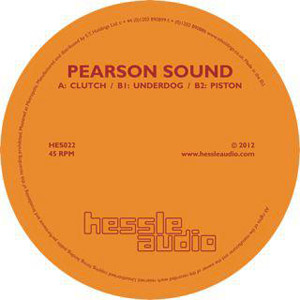Pearson Sound Clutch EP
It’s a direction David Kennedy has been steadily moving in since Ramadanman gave way to […]

It’s a direction David Kennedy has been steadily moving in since Ramadanman gave way to Pearson Sound (an evolution similarly reflected by the direction that Hessle Audio, the label Kennedy of course co-heads, has gone in), but it’s still a bit surprising to hear how much the three tracks on the Clutch EP have been stripped to their bones. Unrelentingly intense in its focus on rhythm, structure, and texture, the record is made up of an efficient core of elements, resulting in a trio of monstrous, atonal sonic workouts.
The a-side, “Clutch,” is the most straightforward offering. Built mainly around tuned 16th-note hats, off-beat percussion, clattering claps, and massive kicks, the tune is an exercise in reductive pattern building. For the first half of “Clutch,” Kennedy’s tight rhythmic assemblages are left to do most of the work, interrupted at repeating intervals by the brief appearance of an overdriven 808 bass drum and shattered drum-machine cymbals. Just after the two-minute mark, the full scope of the track is revealed when a dark synth line is introduced, matching the hat patterns exactly in rhythm and tuning. From there, Kennedy works the song in expert fashion—dropping pieces here, adding spurts of percussion there, while never harking back to the distorted interruptions of the song’s earlier half. The London producer’s apt touch for appropriately minor tweaks somehow gives “Clutch” a natural progression, making the song feel like the product of more than mere looping, despite the fact that it is, at its core, simply a collection of pilings of revolving arrangements.
“Underdog” and “Piston” round out the EP in slightly more unusual territory. Built from similar sets of solid drum tones, the pair of tunes (which together make up the b-side of the EP’s vinyl version) incorporate just a bit more straight-up musical content than their a-side counterpart, with the former employing a loop (which plays both forward and in reverse) of wind-chime-esque notes and the latter embedding actual melody in the proceedings with sequences of reverb-washed synth cascades. These almost gentle facets of the songs are juxtaposed with aggressive drum tones organized with precisely sharp turns and sounding as if they were pulled from a decade-old drum & bass kit; nonetheless, they’ve all still been rendered with Kennedy’s refined, hi-fi touch.
The Clutch EP blurs the line between DJ tools and efficient compositions. Minimal in their usage of elements—but also somewhat maximal in their incorporation of seemingly unrelated sound sources—these cuts push Pearson Sound’s style further out than it’s ever been. Somewhere between unexpectedly defying sonic boundaries and searching for inventive, bass-driven dancefloor methods, Kennedy appears nowhere near the end of his pursuit of dance music’s constantly evolving cutting edge.

